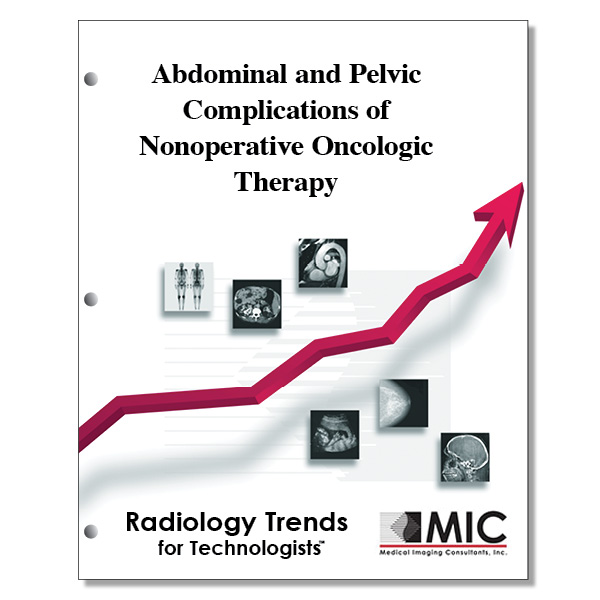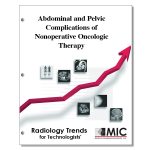

Abdominal and Pelvic Complications of Nonoperative Oncologic Therapy
A review of chemotherapeutic agents, and timing and types of radiation that affect gastrointestinal organs, as well as image examples of complications of therapy and recurrent tumors.
Course ID: Q00431 Category: Radiology Trends for Technologists Modalities: CT, Radiation Therapy3.25 |
Satisfaction Guarantee |
$34.00
- Targeted CE
- Outline
- Objectives
Targeted CE per ARRT’s Discipline, Category, and Subcategory classification for enrollments starting after May 9, 2023:
[Note: Discipline-specific Targeted CE credits may be less than the total Category A credits approved for this course.]
Computed Tomography: 1.00
Procedures: 1.00
Abdomen and Pelvis: 1.00
Magnetic Resonance Imaging: 1.00
Procedures: 1.00
Body: 1.00
Nuclear Medicine Technology: 1.00
Procedures: 1.00
Endocrine and Oncology Procedures: 1.00
Registered Radiologist Assistant: 3.25
Procedures: 3.25
Abdominal Section: 3.25
Radiation Therapy: 3.25
Procedures: 3.25
Treatment Sites and Tumors: 3.25
Outline
- Introduction
- Chemotherapeutic Agents
- Radiation Therapy
- Effects of Chemotherapy
- Liver
- Fat Deposition
- Hepatic Capsular Retraction
- Portal Vein Thrombosis
- Hepatic Veno-occlusive Disease
- Hepatic Congestion
- Spleen
- Splenic Rupture
- Therapy-induced Splenomegaly
- Spleen after Use of Thorotrast
- Pancreas
- Bowel
- Enteritis
- Colitis
- Bowel Perforation, Fistulas, and Delayed Anastomotic Leak
- Perforation and Fistula
- Delayed Anastomotic Leak
- Graft-Versus-Host Disease
- Pneumatosis
- Vessels
- Vascular Complications
- Bleeding
- Peritoneum and Mesentery
- Liver
- Radiation-induced Changes
- Liver
- Pancreas
- Spleen
- Stomach and Duodenum
- Small Bowel
- Large Bowel and Presacral Space
- Kidney, Ureter, and Bladder
- Bone
- Radiation-induced Tumors
- Summary
Objectives
Upon completion of this course, students will:
- identify the primary imaging modality that is typically used for diagnosis, staging, and follow-up of cancer
- know the cell types affected by cytotoxic agents
- be familiar with Topoisomerase inhibitors and other chemotherapeutic agents
- be familiar with targeted chemotherapeutic agents, their indications and side effects
- identify the most common type of radiation therapy
- be familiar with the complications of chemotherapeutic agents by organ
- be familiar with the typical locations of focal fat deposition in the liver from oxidative stress from chemotherapy
- be familiar with the complications of chemotherapeutic agents
- understand why a clinician should be alerted to imaging findings of steatosis or steatohepatitis
- be familiar with the patient diagnoses where hepatic capsular retraction may be visualized after chemotherapy
- be familiar with the appearance of hepatic capsular retraction on CT and MR
- be familiar with the appearance of portal vein thrombosis at imaging
- be familiar with the pathologic process of hepatic veno-occlusive disease
- know the patient symptoms of hepatic veno-occlusive disease
- identify the possible method of differentiation between hepatic veno-occlusive disease and graft-versus-host disease
- be familiar with the imaging findings of hepatic veno-occlusive disease
- know the condition with which hepatic congestion may be associated
- be familiar with the imaging findings of hepatic congestion
- understand the issue of administering imatinib in conjunction with clopidogrel
- know how splenic rupture demonstrates at CT imaging
- be familiar with the symptoms of therapy-induced splenomegaly with which patients may present
- know the product details of Thorotrast
- be familiar with the appearance of pancreatitis at CT imaging
- know the area of the bowel that is most commonly involved with enteritis
- know how a pseudomembranous colitis diagnosis is confirmed
- be familiar with the CT imaging findings of a delayed anastomotic leak
- be familiar with the imaging findings of acute and chronic GVHD
- know the conditions for which patients are receiving chemotherapeutic agents which can cause pneumatosis
- know the sign of thromboembolism seen at CT and ultrasound imaging
- know the clinical clues to the presence of hemorrhage
- understand the organ tumors treated with irradiation which put the liver at risk
- be familiar with the radiation damage progression pathway in the liver
- be familiar with how radiation damaged liver tissue appears at imaging
- be familiar with the presentation of chronic radiation injury to the liver
- understand the side effects of pancreatic irradiation
- be familiar with the secondary signs of pancreatic tumor recurrence
- understand the effects of irradiation of the spleen
- be familiar with the findings of acute radiation injury when irradiating the stomach and duodenum for retroperitoneal and upper abdominal tumors
- be familiar with the CT findings in the small intestine which, in the absence of a mass, are more indicative of irradiation injury than recurrent tumor
- know the most common location of insufficiency fractures from irradiation
